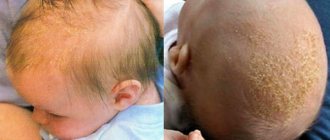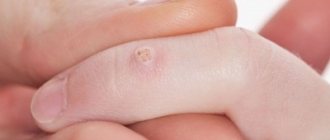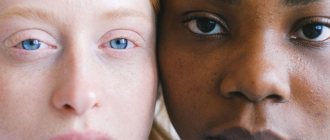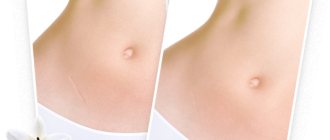05/27/2021 Reading time: 5 min 15991 0
By the end of the first month of life or a little later, yellowish crusty scales can be noticed on the baby’s scalp. They can frighten and upset a mother who is unprepared for such a phenomenon, but meanwhile there is nothing terrible about them. Milk crusts, which actually have nothing to do with milk, occur in many children under one year old. In medical terminology, they are called seborrheic dermatitis, physiological seborrhea or gneiss.
Causes (etiology) of diabetes in infants:
Unfortunately, at the moment there is no information about the exact cause of seborrheic dermatitis, but several risk factors for its development can be identified:
- colonization of the skin by yeast fungi of the genus Malassezia;
- increased secretion of sebaceous secretions (oily skin);
- immunodeficiency conditions (HIV, patients after transplantations, etc.);
- heredity (history of the disease in close relatives);
- unfavorable climate (spring-autumn exacerbations are typical).
Why does atypical seborrhea occur?
The causes of dermatitis are the following:
- A specific yeast fungus that multiplies especially rapidly on the skin of newborns;
- Hormonal imbalance caused by the gradual elimination of maternal hormones from the child's body;
- Dysfunction of the digestive tract and associated allergic conditions.
Factors aggravating the course of dermatitis include dysbacteriosis, severe pregnancy in the mother, artificial feeding and gross failure to comply with hygiene rules.
If there are two of the listed circumstances in the anamnesis, then in addition to a scheduled visit to the pediatrician, the baby may need to consult a dermatologist.
Symptoms of seborrheic dermatitis
Childhood diabetes is characterized by gradual development and diffuse rashes in certain places - most often on the scalp (including along the hairline), on the face (in the area of the nasolabial folds and along the eyebrows), and also under the diaper.
Based on skin manifestations, seborrheic dermatitis is divided into several types:
- Oily type - the appearance of oily crusts on the scalp, and the appearance of acne on the face is also possible.
- Dry type - the appearance of dandruff on the head, as well as cracks in the area behind the ear.
- Mixed type - manifestations of both types are observed.
In infants, DM often develops in the oily type - in the form of a lesion on the scalp, covered with a thick yellow crust (gneiss, “baby cap” or “milk crust”) and the appearance of yellow flaky scales of characteristic localization (see above). In addition, another type of rash can also be detected on the skin of the face - clearly defined pink-red plaques covered with whitish scales. The same rash can be observed in the diaper area.
Why do crusts appear on the head?
The exact cause of scalp crusts is unknown, but experts do not attribute the appearance of crusts to allergies or poor hygiene. One factor may be the transfer of mother's hormones to the baby during pregnancy, which causes excess sebum to form in the sebaceous glands and hair follicles. Another factor may be a type of malassezia fungus that lives in the sebum along with bacteria.
Washing your baby's hair daily with a mild baby shampoo will help prevent crusting.
Differential diagnosis of diabetes and other dermatological diseases
Diagnosis of seborrheic dermatitis is based on the clinical picture and includes assessment of the nature of the rash (color, shape, and other properties), its location and symmetry. Sometimes it is necessary to use microbiological diagnostics if there is a suspicion of an initially infectious nature of the rash or the addition of a secondary bacterial/fungal infection.
The difficulty in diagnosing seborrheic dermatitis lies in making a correct differential diagnosis with other clinically similar dermatological diseases, because psoriasis, atopic dermatitis, lichen planus, and rosacea (rosacea).
Preparations with zinc pyrithione
For mild to moderate seborrheic dermatitis on the head in infants, preference may be given to non-hormonal anti-inflammatory drugs based on zinc pyrithione. For example, Skin-cap shampoo containing activated zinc pyrithione has anti-inflammatory, sebum-regulating, and antimycotic effects. Skin-cap shampoo is prescribed as the main method of treatment to soften crusts and eliminate inflammation; in the future it can be used to prevent relapses of the disease. The activated zinc pyrithione contained in Skin-cap shampoo helps:
- reduce the intensity of inflammation;
- reduce the activity of fungi and bacteria;
- effectively moisturize the skin;
- eliminate peeling, feeling of skin tightness;
- reduce itching.
It is thanks to this combination of effects that Skin-cap shampoo can be used during an exacerbation of seborrheic dermatitis in an infant, then the treatment will be more effective. You can combine the use of Skin-cap shampoo with accompanying medications, including it as part of complex therapy.
Treatment with medications is supplemented by general recommendations for changing diet and caring for the baby. If seborrheic dermatitis is detected on the face of a baby , it is recommended to exclude foods with potential allergens from the diet. You should not put synthetic clothing on your baby so that the skin is not subject to friction and irritation. Parents should pay special attention to the selection of laundry detergents, choosing products without aggressive substances in their composition.
The likelihood of stress for a child needs to be reduced as much as possible, so it is important to maintain a favorable psychological environment in the family.
Treatment and care for seborrheic crusts in children
Seborrheic dermatitis may resolve without treatment, but relapses are common after periods without clinical manifestations. If treatment is still necessary, then to correctly prescribe it, you need to contact a specialist - a pediatric dermatologist.
Often the basis of treatment is the selection of special medicinal cosmetics: shampoos, lotions and creams that can gently cleanse the scalp of crusts and remove excess sebaceous secretions from the facial skin. In addition, for children it is important to select products that can relieve itching, because... additional scratching of the rash can lead to secondary infections.
For treatment, products are used that contain the following components:
- keratolytics (eg salicylic and lactic acids) - to soften the top layer of skin;
- antifungal agents - when mycoses are attached;
- local corticosteroids - to relieve inflammation;
- in severe cases, phototherapy and the use of isotretinoin to reduce seborrhea are justified.
Skin care for children with diabetes should be regular (daily) to improve the course of the disease and speed up recovery. Children's cosmetics for skin care with diabetes are classified as medicinal products and therefore are selected only by a specialist (pediatric dermatologist). Care includes the following procedures:
- Applying baby cosmetic oil before washing your hair to soften seborrheic crusts.
- Wash your hair with a special shampoo using gentle massaging movements to avoid skin trauma.
- Daily treatment of rashes on the face, along the hairline and in the area behind the ear with a special cream or lotion.
- Thoroughly dry the skin after hygiene procedures to prevent the appearance of a damp environment favorable for the development of microorganisms.
How to remove crusts on a child's head?
Thick crusts can be difficult to remove, try the recommended procedures:
- Once a day, when you bathe your baby, wash his hair with mild baby shampoo. Ask your pediatrician to recommend a shampoo for scalp crusts.
- Gently comb out the flakes with a comb or soft scalp brush and then rinse off the loose flakes with water. Do not rub or scratch your skin.
- You can also use baby oil or vegetable oil. Before combing out the scales, lubricate the child's head with oil; it will moisturize the skin and help loosen the scales on the head, making them easier to remove. After the procedure, wash the baby's head with shampoo.
How to eat to avoid dandruff
The child must necessarily consume vitamins such as A, B, E, and fiber with food. This is found in foods such as potatoes, bananas, bran, brewer's yeast, carrots, and greens. Particular attention should be paid to vitamin B - it is the lack of this vitamin, as well as zinc, that most often causes dandruff. It is not for nothing that in Soviet times, children were given fish oil rich in vitamin B.
Explain to your child that it is important to avoid fatty oil products that cause hyperfunction of the sebaceous glands. This list includes: fried meat, sausage, chips, crackers, French fries. In addition, sweet carbonated drinks, packaged juices, mayonnaise, and fast foods are harmful. Unfortunately, in practice, parents often fail to convince their child that such food is harmful to the body. A visit to a trichologist can be an effective way to solve this problem, because often the doctor looks more authoritative in the eyes of a child when talking about the dangers of fast foods.
A child’s daily diet must include fresh vegetables and fruits, meat, dairy (fermented milk) products, whole grain bread, seeds and/or nuts, and herbs. In winter, you can give multivitamin complexes.
Summarizing all of the above, we conclude that dandruff is not a particularly dangerous disease. However, the child’s immune system is not yet capable of providing reliable protection, and “white snow” on the hair and shoulders should serve as the first “bell” for parents, forcing them to carefully analyze some aspects of their child’s life.
A competent trichologist will undoubtedly help you make such an analysis comprehensively and with correct conclusions. At the MediLife clinic in St. Petersburg, you can get a consultation with a trichologist at any time convenient for you by making an appointment. High professionalism and an individual approach to the patient will allow you to solve the problem in the most optimal and loyal way.
St. John's wort ointment
A good remedy for treating seborrheic dermatitis is an ointment made from the herb St. John's wort. The medicine is prepared as follows. Take fresh shoots of a medicinal plant. St. John's wort is thoroughly crushed. The resulting mass is placed in gauze and the juice is squeezed out. The liquid is placed on low heat and thoroughly evaporated until a substance with a viscous consistency is formed. The base of the medicine is combined with butter in a ratio of 1:4. The composition is thoroughly mixed and then placed in the refrigerator for a day. Areas of the scalp affected by seborrhea are lubricated with the medicine 2-3 times a week.
Removing scales with a comb
To combat the formation of characteristic scales, periodically use a comb that has rounded teeth. Remove crusts that come off easily. Try not to further injure the delicate epidermis. Remove flakes stuck in hair. Perform this procedure daily. Make sure your child touches his head as little as possible. Regularly scratching irritated skin with dirty hands is fraught with the development of infections in the structure of local tissues.
Prevention of dandruff in children: prevention is easier than cure
Preventive measures that will help reduce the likelihood of an unpleasant disease occurring should include:
- organization of proper nutrition;
- organization of proper sleep and wakefulness;
- maintaining hygiene: do not wear other people’s hats, use only your own comb, preferably made of natural wood, and regularly replace it with a new one;
- be in the sun, but in moderation - ultraviolet rays kill the fungus, but dry the skin.
Burdock infusion
A fairly effective folk remedy in the fight against seborrheic dermatitis is burdock infusion. The medicine is prepared according to the following scheme:
- Take several shoots of burdock.
- The raw materials are passed through a meat grinder or crushed in a blender.
- The pulp is placed in a piece of gauze and the juice is squeezed out.
- About 2 teaspoons of the substance are combined with a few drops of burdock oil.
- Add half a dessert spoon of liquid honey to the composition.
- The resulting mass is mixed until a homogeneous consistency.
- The product is left to infuse for 24 hours.
The medicine is applied to damaged scalp. Place a layer of cling film on top. The baby's head is covered with a cap. After an hour, the product is thoroughly washed off with warm water. The hair is allowed to dry without using a hair dryer. Therapy is performed several times a week. The method allows you to eliminate severe symptoms of seborrheic dermatitis within a month.










